* This next part of the tutorial assumes that you have completed all the steps in the previous sections
One of Entering the Schematic using a local CIS database, or Entering the Schematic using online component sources, or Entering the Schematic using generic libraries and, optionally, Simulating the headphone circuit with PSpice.
Physical Layout with OrCAD X Presto
After you have completed your design, it is recommended that you run a design rule check (DRC) to isolate any unwanted design errors that might be there. To run a DRC on the headphone design, complete the following steps:
1. In the Project Manager pane select the design file headphone.dsn.
2. From the PCB menu select Design Rules Check
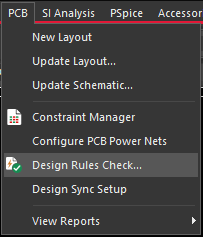
3. In the Design Rule Check dialog box, check Options for DRC Action, Run on Design.
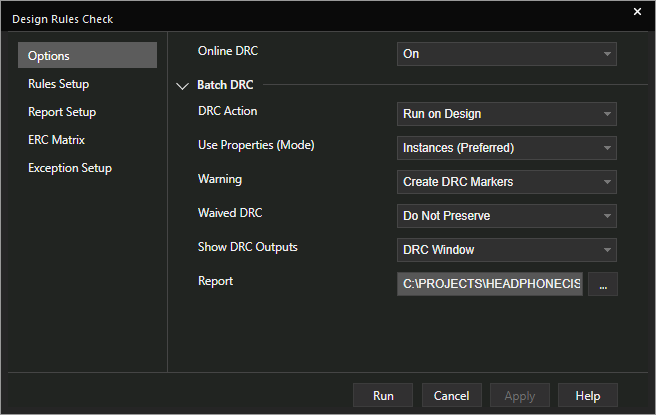
4. Left-click the Rules Setup and Report Setup on the left to view the settings.
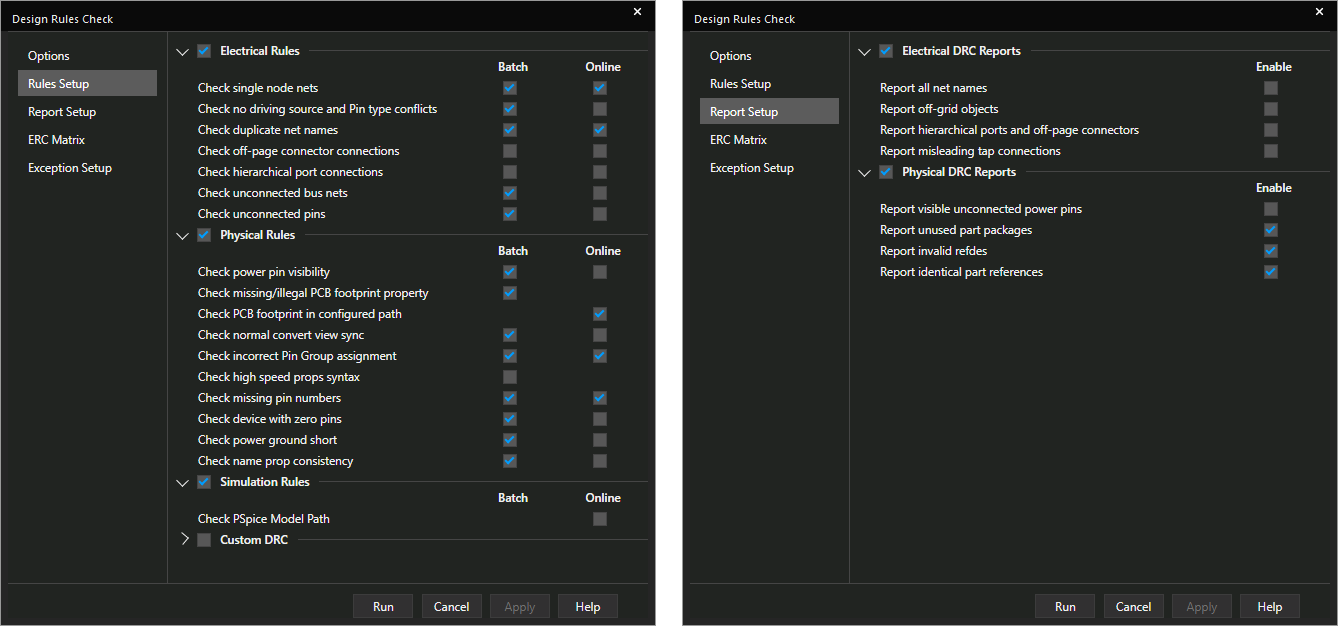
5. To run the DRC, left-click>Run.
The DRC report is generated. To view you can either look at the Session log or access the report from the Outputs folder of the Project Manager pane.
Note that a DRC Warning will be flagged for the PARAM part in the Schematic. As this part has no Pins, the "Check device with zero pins" batch DRC option gets this warning issued. This DRC Warning can be ignored as it won't have any impact on any subsequent steps
OrCAD X Presto initial configuration when using footprints from the download data
Start OrCAD X Presto 24.1 from the Cadence OrCAD X and Allegro X 24.1 Windows Start Menu group. If you see Cadence Product Choices, pick an OrCAD X Standard, or OrCAD X Professional, or OrCAD X Professional Plus license and left-click>OK. Use File>Open to open any board file or use File>New to create a default board file, then start Edit>Preferences. In the Libraries group, select Directories and Paths. Left-click the “…” button for “Footprint .PSM search path” and use the “+” icon to add a new entry and left-click the “…” button to browse to the location of the symbols folder that the downloaded data was saved to. Left-click>Choose and use the “up arrow” to move that location to the top of the list and left-click>OK.
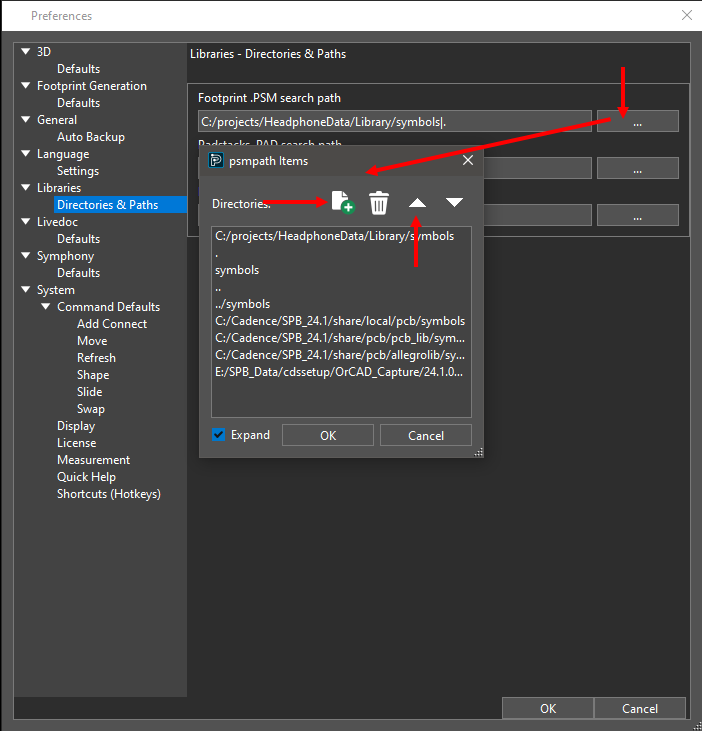
Repeat the steps to add that location to the “Padstacks .PAD search path”. Close OrCAD X Presto for now.
(This isn’t required for the online component sources, or using the generic libraries from the installation, as the path values are set by default.)
Creating the initial board from OrCAD Capture CIS
If not already open, start OrCAD Capture CIS and open the headphone design.
In the Project Manager pane select the design file entry headphone.dsn.
From the PCB menu select Design Sync Setup. Change the “Select Layout tool” drop-down to OrCAD X Presto and left-click>OK
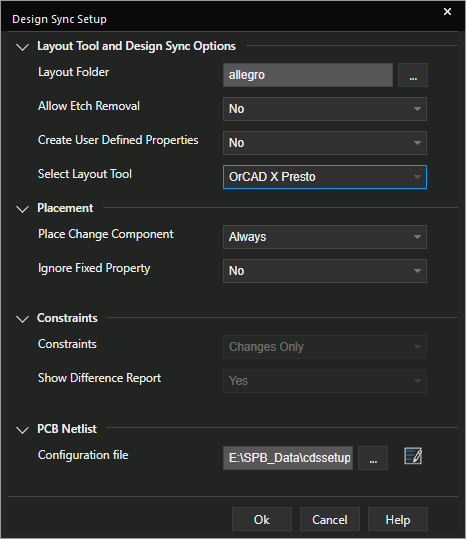
From the PCB menu, select New Layout
Check that the Input Board File is empty to create a board with a default template and left-click>OK
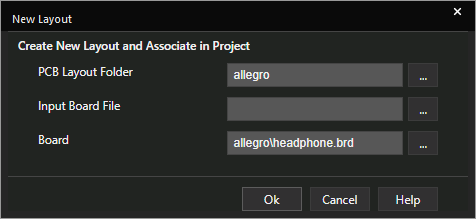
If you see Cadence Product Choices, pick an OrCAD X Standard, or OrCAD X Professional, or OrCAD X Professional Plus license and left-click>OK.
The board file, headphone.brd based on a default template, opens in OrCAD X Presto
Capture can be closed at this point, "Yes All" to save any changes.
Setting up OrCAD X Presto
These next few steps will guide you through some basic settings inside OrCAD X Presto for this tutorial.
Use the Properties panel on the right and, in Parameters, change the “Units” to “mm” and the “Accuracy” to 4. Leave the other Parameters for now.
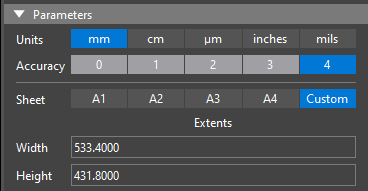
Use Tools>Cross Section from the menu to open the cross section editor.
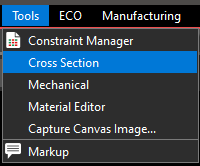
Here is the initial cross section and default material parameters:

To illustrate changing the cross section, the Conductor material will be changed to Half Oz Copper. Left-click in the Material cell for each conductor layer and select the Half Oz Copper material.
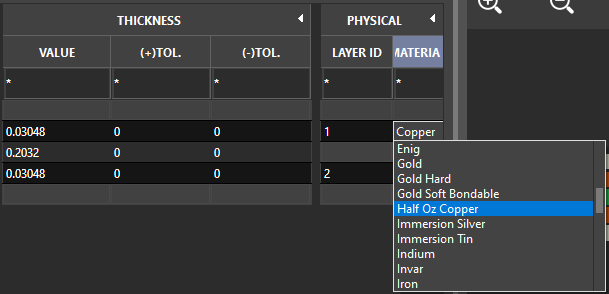
The Thickness and Tolerance will be filled in from the materials settings. Left-click in the Thickness Value cell for the Dielectric layer to get to a total of 1.62mm for the board thickness. That's 1.58444mm in this case.
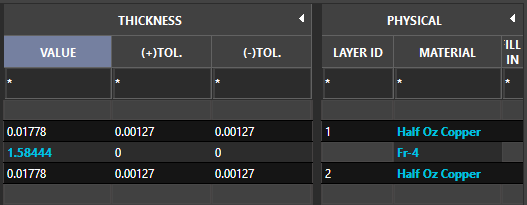
Left-click>OK to close the cross section editor and accept the changes.
Zoom into the lower left of the outer rectangle of the default board by hovering the mouse inside the lower left corner of the rectangle and rolling the mouse wheel to zoom, then left-click to select the outer rectangle. With the rectangle selected, move to the Properties pane and left-click on “Pick Origin Location” and move to the lower left corner of the selected rectangle and left-click to set the origin.
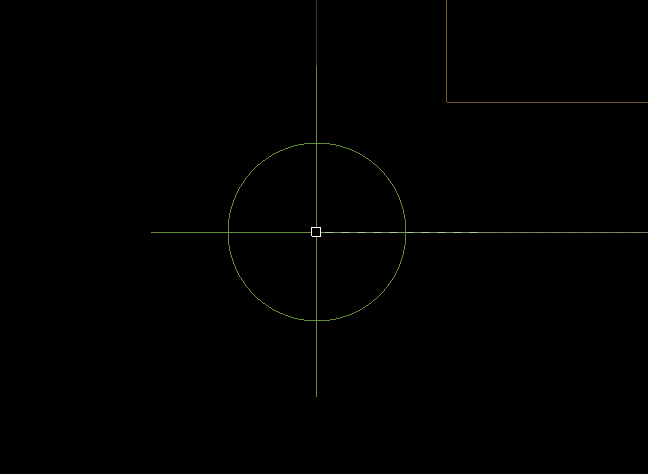
Move back to the Properties pane and set the Length X to 40, Height Y to 50, the Conductor Keep-in to 0.5 and the Component Keep-in” to 1.0
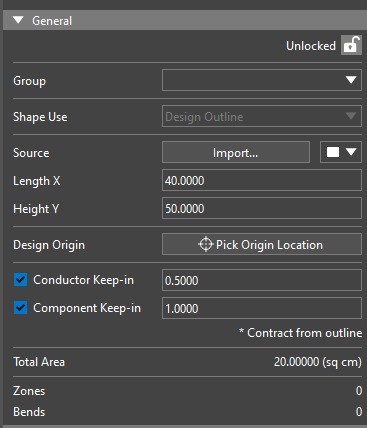
Left-click in the Background canvas to deselect the outer rectangle and, in the Properties pane, change the Sheet to A4
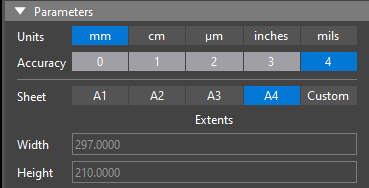
Use File>Save headphone.brd to save, and overwrite, the board at this point
This tutorial uses a simple rectangle for the Design Outline which defines the boundary of the PCB. This can be used for ECAD-MCAD Transfer using DXF, IDX and MCADX as well as manufacturing data. The rectangular Design Outline cannot be deleted but it can be replaced by ECAD-MCAD imports.
Use View>Zoom>Zoom Fit to fit the Design Outline to the canvas
If required, you can adjust the colours of the layers (called Classes and Subclasses). To do this left-click on the Visibility bar on the left. Design_Outline, for example, is at the bottom on the Objects and Areas group. Left-click on the colour square to the left of Design Outline to open the colour picker and select a “base” colour from the presets and change this as required. This method can be used to change any other colours.
Adding Mounting Holes
Now that we have a board outline, let's add some mounting holes to the PCB.
1. Take Tools>Mechanical. You will see a list of default Mechanical Symbols to choose from.
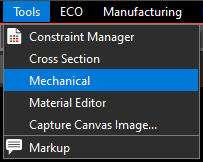
2. Select the MTG125 from the list and place 4 of these on the canvas with left-clicks.
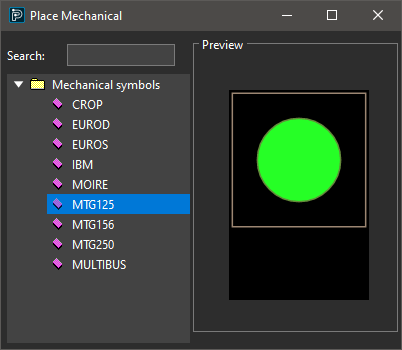
3. Using the Select, “pointer” from the left-hand toolbar, select one of the placed mounting holes in turn and set the location, from the Properties panel, to the following X / Y locations: 3.5 / 3.5, 3.5 / 46.5, 36.5 / 3.5 and 36.5 / 46.5 Use Enter to set the parameters and tab to move between the fields.

4. Press Esc to end placing the Mechanical Symbols.
(The placed mounting holes could be fixed by selecting them and left-clicking the “padlock” in the Properties panel)
5. Use File>Save headphone.brd to save the board.
Assigning colours to identify Nets
To aid placement and routing, Nets can have colours assigned.
1. Left-click Visibility at the top of the left-hand bar or use View>Panes>Visibility if it is not displayed.
2. In Visibility, below Search are Layers, Nets and Display, left-click on Nets
3. If necessary, expand Nets with a left-click on the "triangle” to the left of Nets (20)
4. Left-click in the square to the left of 0 to open the colour assignment and pick a colour. The following screen shots used green. Left-click the green Preset and drag the circle in the shaded colour picker to upper right. Left-click in the Visibility pane background to close the colour picker and set the colour. (Note that the Net Name may be GND if the PSpice simulation setup steps weren't taken when creating the schematic)
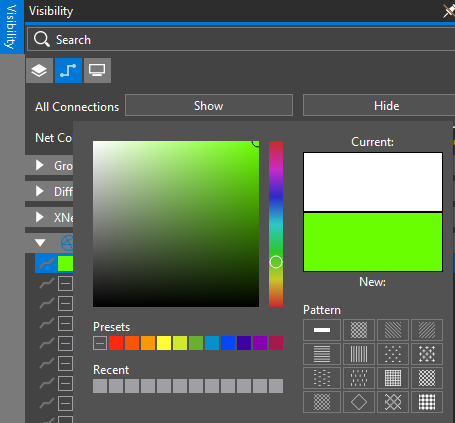
5. Repeat the previous step for the Vpp entry and assign the yellow preset to match the screen shots.
6. Repeat the assignment step for the Mid entry and assign the darker blue preset to match the screen shots.
Use other colours if you prefer. Left-click the Visibility tab at the upper left, or left-click in the Presto canvas to hide the Visibility panel
Placing Components.
After you have created the board outline, placed the mounting holes and assigned Net colours you can start to place the components in the board. OrCAD X Presto supports both manual and automatic placements. For manual placement you can place parts: from the schematic one part at a time, or in clusters; from the search list; or by importing the placement.
In this section we will use manual placement from the search list to create the PCB for the headphone design.
1. For this example, in Grids and Snapping, ensure that Grids are Off, and all Snapping is Off as well. This will allow the Parts to be placed in an effectively “gridless” mode. By all means experiment with the Grids and Snapping settings, Alignment Guides, for example, will get guide lines displayed as parts align.
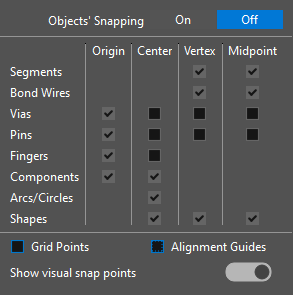
2. To access component placement, move to the orthogonal 4 headed cross in the left-hand toolbar, right-click to see the options, and left-click the Place "component" icon.
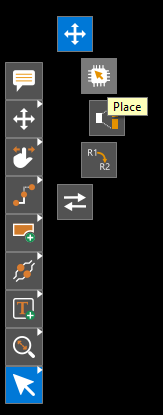
3. In the panel that pops up, left-click in the button that has the arrow pointing to the upper right, this opens the Search pane at the bottom of the screen.
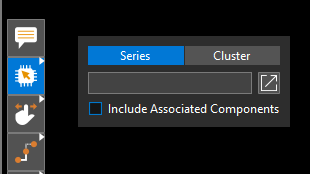
4. In the Search panel: individual components can be selected; or a sequence of components selected by using left-click and the shift key with a left-click to add a range; or use the control key with a left-click to add more components to the selection one at a time. Once the components are selected, moving to the canvas will have the first component attached to the cursor, left-click to place and the next component, if there are any remaining in the selection, will be attached to the cursor for placement.

Left-click and drag on placed components to move components around.
When placed, components in the Search panel will get an X / Y location and a Status of placed.
The X / Y location can be edited within the search panel as a means of moving and aligning components. To see the Search panel when not in “placement”, use View>Panels>Search. A left-click in the canvas will hide the Search panel unless pinned.
See this shot of a sample placement. (Note that your Reference Designators may differ depending on the schematic entry session followed)
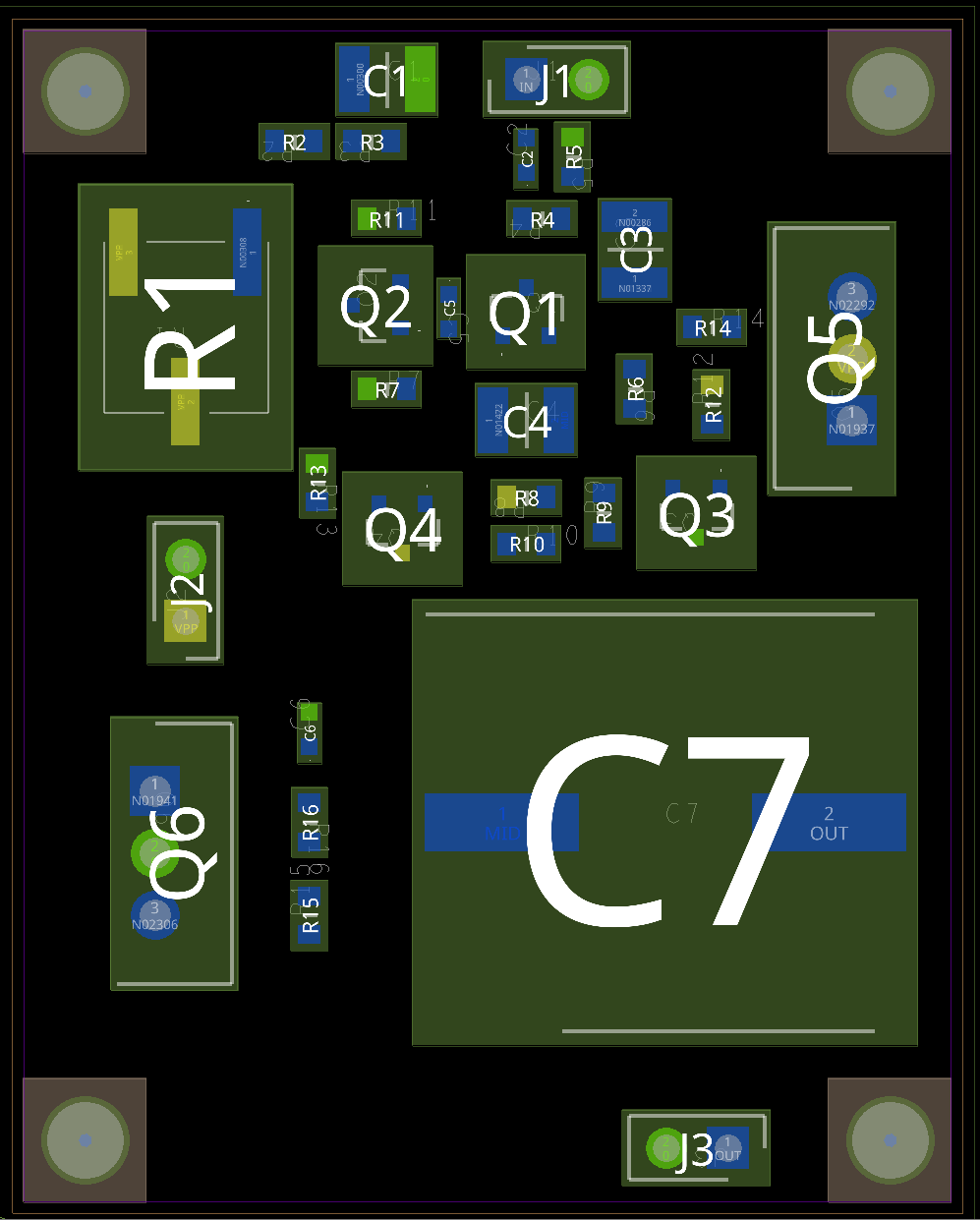
The components with Pins connected to the Vpp Net are roughly grouped around the centre of the board so that a Shape can be used to connect them in later steps.
(Feel free to experiment with placing from the Schematic which require both OrCAD X Capture and OrCAD X Presto running side by side. With Placement active, left-click a component in the Capture Schematic and it will be attached to the cursor when moving to the OrCAD X Presto canvas.)
If you are using the online component sources, you may find that the footprints are somewhat larger than the footprints used for the CIS database approach. Select the lower left corner of the board outline and enlarge the outline, as necessary, to ease the placement process.
Tip: To Find a component in OrCAD X Presto: get the Search panel open, use the Search at the top to specify the RefDes required and press the Tab key. In the results list, right-click>Zoom on the entry to move the display to the selected component. Left-click>Reset in the Search panel to clear the filter.
Design Rule Checking
OrCAD X Presto actively maintains the DRC, Design Rule Check, Status, the result of which is displayed in the Properties panel. A green “Up to Date” means that there are no DRCs in the design. DRCs may be “Out of Date” because Shapes need updating and the DRC status cannot be verified unless the Shapes are updated. The Properties panel will show the status of “Out of Date” Shapes. Left-click on the circular arrows for any “Out of Date” item in the Properties panel to perform the update. Update “Out of Date” Shapes before updating “Out of Date” DRCs. A number to the right of DRC Errors will show the number of DRC Errors. A left-click on the number will open the Search panel with the current DRCs listed.
Setting the Design Constraints
To configure the basic spacing and physical constraints for your board design, select Tools>Constraint Manager. A window appears showing the default settings. For this tutorial, rules will be configured for “default” and “power” Nets.
1. Use Tools>Constraint Manager to launch Constraint Manager.
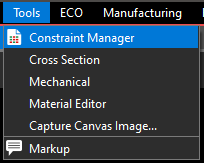
2. Left-click Physical on the left.
3. Left-click in Physical Constraint Set, All Layers
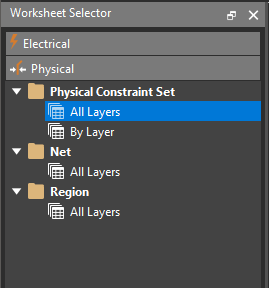
4. Change the value for the DEFAULT rule for Min in Line Width to 0.25
5. Change the value for the DEFAULT rule for Min in Neck Width to 0.25

6. Left-click in the Via cell for the DEFAULT rule. In Filter by Name type via to filter the via names. Double-click VIA-0_5-0_2 from the list to add to the Via List. Select the default VIA entry in the Via List pane and left-click>Remove. (or double-click the entry to remove it) Then left-click>OK to set the Vias in the design.
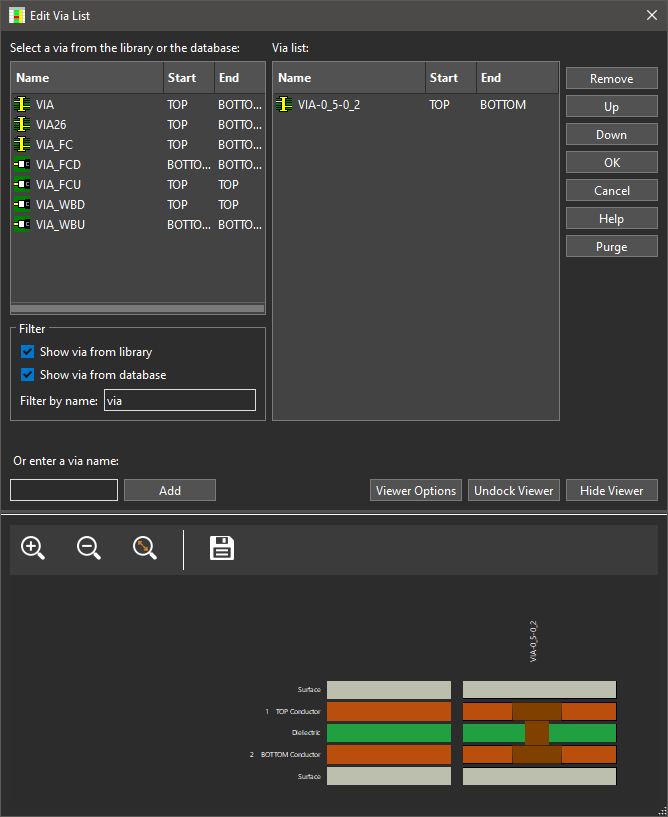
(The required VIA-0_5-0_2 is in the downloaded data. Leave the VIA entry, which will be a larger via, if not using the downloaded data)
7. Right-click in the DEFAULT cell and take Create>Physical CSet, name the new CSet power (This will be converted to uppercase after the OK) and left-click>OK

8. Change the value for the POWER rule for Min in Line Width to 0.5

9. Move to Net, All Layers. Right-click in the Headphone cell and take Create>Class, name the new Class Power and ensure that Create for both physical and spacing is enabled.
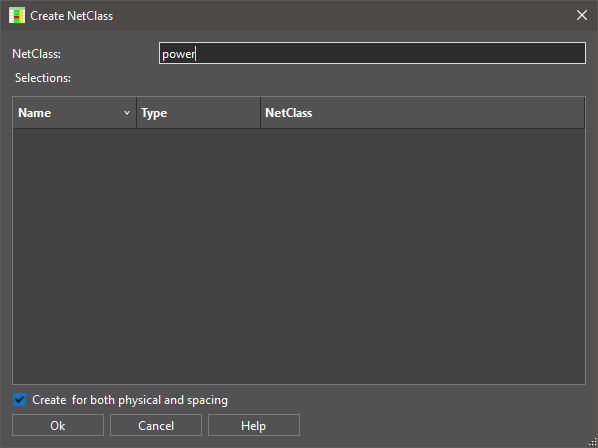
10. Locate the 0 Net in the list and use right-click>Add to>Class select POWER from the drop-down at the top and left-click>OK to add the Net to the Class.

11. Repeat the previous step to add the VPP Net to the POWER Class.
12. In the POWER Class, left-click in the Referenced CSet cell and select POWER from the drop-down.
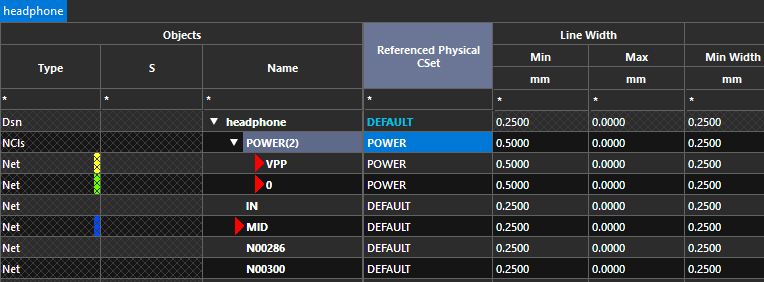
13. Now move to Spacing on the left with a left-click.
14. Left-click, Spacing Constraint Set, All Layers
15. Left-click in the Line To cell for DEFAULT, ensure that the cell is selected and not the value, then drag the mouse to the Bond Finger To cell to select the row. The Bond Finger To cell will be opened for editing, change the value to 0.25 and press Tab, or Enter, to set the values.

16. Right-click in the DEFAULT cell and take Create>Spacing CSet, name the new CSet POWER and repeat the previous step to set the values to 0.4

17, Move to Net, All Layers and left-click in the Referenced CSet cell for the POWER Class and select POWER from the drop-down.
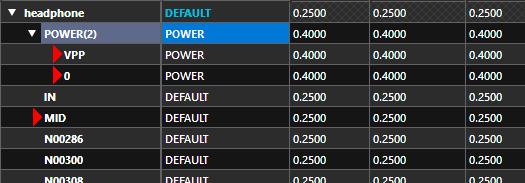
Routing
After completing the board placement, you can route the headphone board to complete the electrical connections between components.
OrCAD X Presto supports manual or assisted routing. For this tutorial, manual routing will be used.
The basic steps involved in the manual routing process are as follows:
Check the board outline, via definitions, routing and via grids.
Route power and ground
Fan out surface mounted devices and verify connections to power and ground.
Route the remaining signals using the manual routing tools.
Optimise routing using the manual routing commands.
Check for route spacing violations and check routing statistics.
Connecting VPP and GND (0) nets
For this tutorial, these Nets are going to be, primarily, connected by Shapes on the Bottom Layer.
1. Open Visibility and Layers, turn Off All Layers, left-click the All square for Bottom, left-click the Pins square for Top and left-click the “crossed eye” for Design_Outline to make that visible. Open Geometries with a left-click on the “triangle” to the left and enable the visibility of both Component Keep-in and Conductor Keep-in. Then close Visibility.
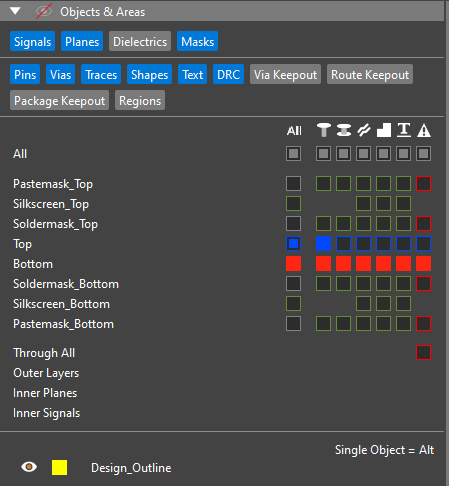
2. In the Grids and Snapping, ensure that Grids are Off, and all Snapping is Off as well. This allows to the Shape to be added in an effectively “gridless” mode.
3. In the left-hand toolbar select Add Shape (Right-click on the Shape entry in the toolbar and left-click to select Add Shape if it isn’t the selected Shape option)
![]()
4. Select the Rectangle tab, the “corners” mode, left-hand icon, Shape Use of Conductor, Layer Bottom, Net Vpp from the drop-down
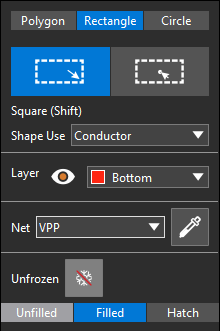
5. Move to the board and left-click to specify the first corner, move the mouse and left-click to specify the second corner. The Shape should roughly cover the yellow Pins of the Vpp Net but remember that the Pins are displayed for the Top and any surface mount Pads will use Vias to connect to the Bottom Layer so there is no need to completely cover all the Vpp Net Pins.
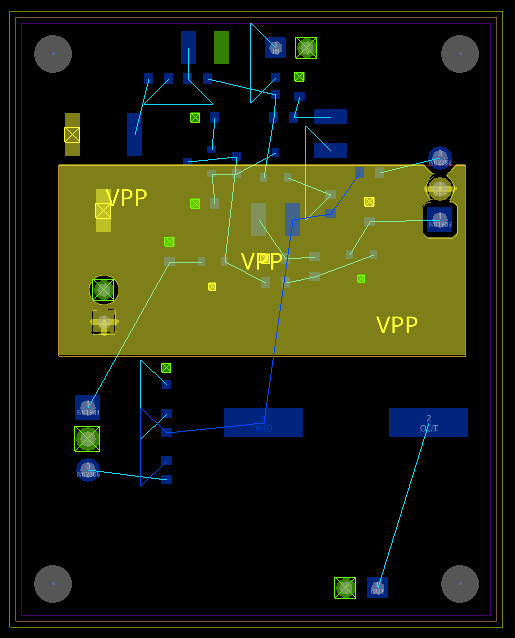
Once the Rectangle has been added, the boundary can be changed with a left-click and drag on the small squares on the Boundary. The Boundary will remain as a rectangle though.
Use the Esc key to finish, control+Z to Undo
6. Once the Shape has been added, it can be refined with a left-click to select the Shape and then a right-click>Edit Boundary.
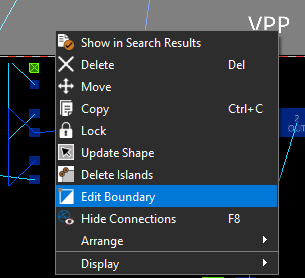
Left-click at the edge of the Shape and move the mouse to start adding a line to change the Shape Boundary. Left-click to add corners as you go. A left-click on the Boundary will cause the drawn section to removed, or added, as the case may be. If required, use control+Z to undo any steps along the way. Once you are happy with the Shape, use Esc to end the command.
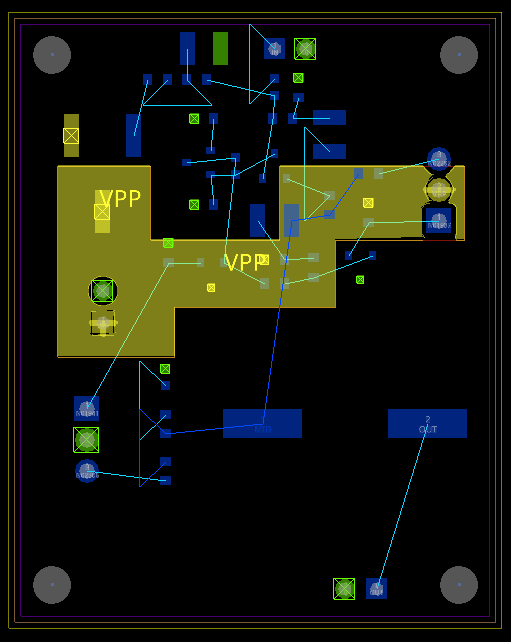
7. Right-click on the Add Shape entry in the left-hand toolbar and select Shape Utilities.
![]()
8. In Shape Utilities, select the Trim Corners tab, select Round as the mode, right-hand icon, set Trim Entire Shape, Radius as the option and set 1 as the Radius value and left-click the Shape to round all the corners. Use Esc to deselect the Shape.
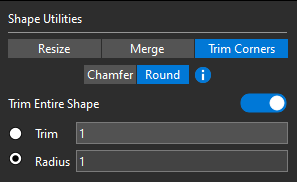
Trimmed Shape:
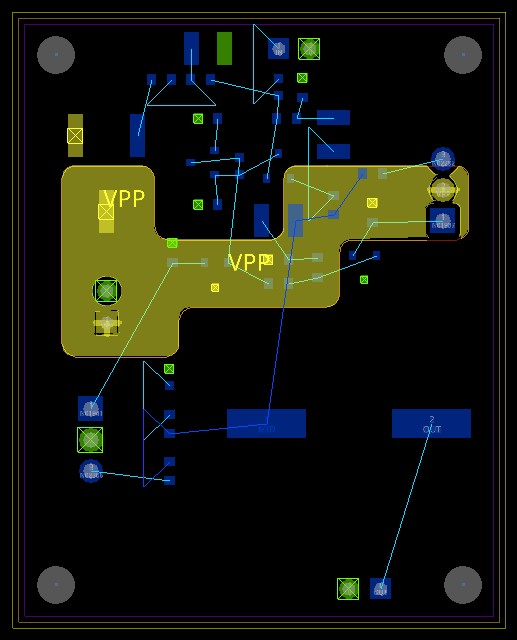
9. Left-click in Grids and set the Quick Grid to 0.5 / 0.5 (Turn On Visibility, if required)
10. Left-click in Snapping and set Objects Snapping to On and enable GridPoints
11. Left-click in the canvas to close Snapping
12. Move to the left-hand toolbar and right-click to change the Shape action from Shape Utilities to Add Shape
13. With the Rectangle tab selected, “corners” mode, Use: Conductor, Layer: Bottom and Net: 0
14. Use two left-clicks to add a rectangle around the current Vpp Shape, then move the Boundary of the Shape to be the same as the Route Keepin and use Esc to end adding the Shape.
The Vpp Shape will be cleared from the added 0 Shape. If that isn’t the case, select the 0 Shape and use Priority in the Properties panel to lower the Shape Priority.

15. Move to the Add Connect section of the left-hand toolbar and right-click to see the options and left-click the Fanout function.
![]()
16. In the Fanout options, left-click the Linear tab and Out, the other options should be fine for these steps.
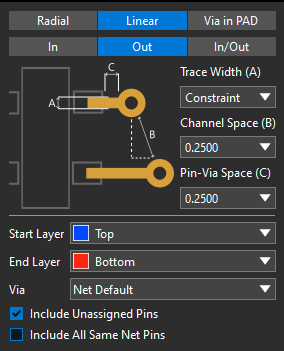
17. Check that only Pins are enabled in the Selection Filter pane of the Properties panel and work through the Pins for the 0 and Vpp Nets, left-clicking to add the fanout.
Connecting the “other” Nets
1. Go to Visibility and, in Layers, turn off all the Bottom objects and turn on all the Top objects.
2. Set the Grids and Snapping as preferred. For example, use a Quick Grid of 0.1 / 0.1 and enable some Snapping options. Pins could be useful, for example. You may find that your preference is to not have any Snapping for the routing process.
3. Change the Fanout option back to Add Connect and check that Start Layer is Top. The other options should be fine.

4. Check that, at least, Pins are enabled in the Properties panel Selection Filter pane
5. Left-click on a Pin to start adding a connection. Left-click to accept what is routed and, potentially, add a corner. Left-click on the target Pin to complete the route. Double-click while routing to add a Via
You could simply left-click on Pins to make the connections and then revise the routing or you could more carefully add the routing avoiding conflicts.
In any case, you may need to delete and reroute some of the connections. Trace Segments and / or Traces will need to be enabled in the Properties panel Selection Filter pane. Select a Trace, or Trace Segment and press the Delete key, or right-click>Delete, to delete the selected item.
To Slide a routed connection, ensure that, at least, Trace Segments are enabled in the Properties panel Selection Filter pane, select Slide in the left-hand toolbar, then left-click on a Trace Segment to attach it to the cursor and move the mouse to change the routing. Left-click to accept the updated routing.
You may also find that, as routing is added, revision to placement is required.
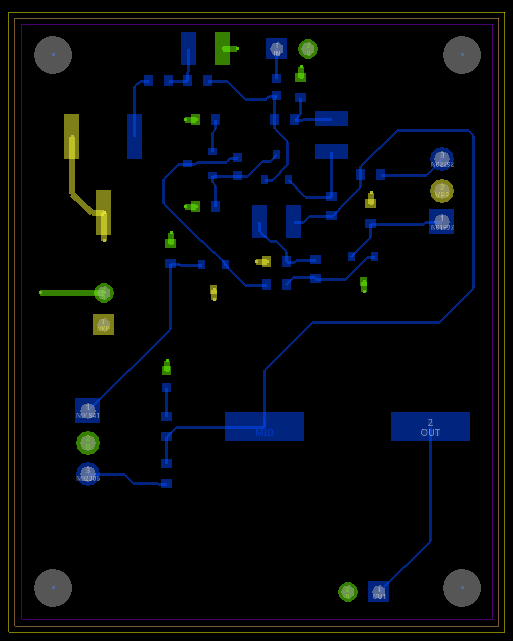
Once you are happy with the placement and routing, move onto the next steps.
Generating output
Nothing gets manufactured without manufacturing data and Manufacturing>Export to Manufacturing provides the function to generate manufacturing data in IPC-2581, ODB++ and Gerber formats, as well as generate reports.
1. From the main menu, take Manufacturing>Export to Manufacturing
2. Scroll through the Exports form to see the options. Configure Artwork Films, at the bottom, provides control over which design layers are included in the output.
3. For these steps, Gerber data and PCB Reports will be generated so, uncheck the Fabrication options and check Fabrication Gerber.
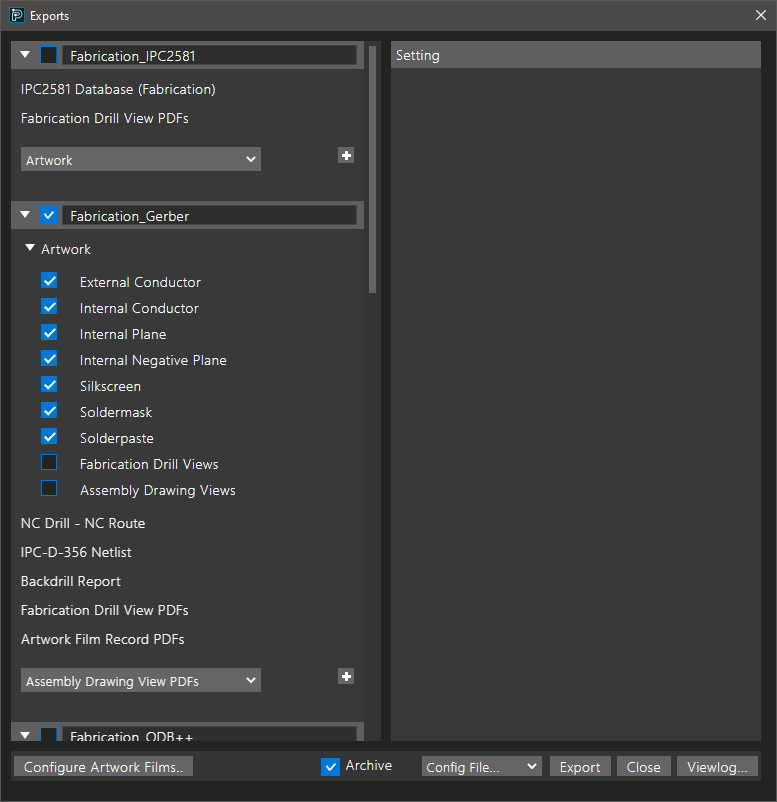
4. Scroll down and check PCB Design Report.
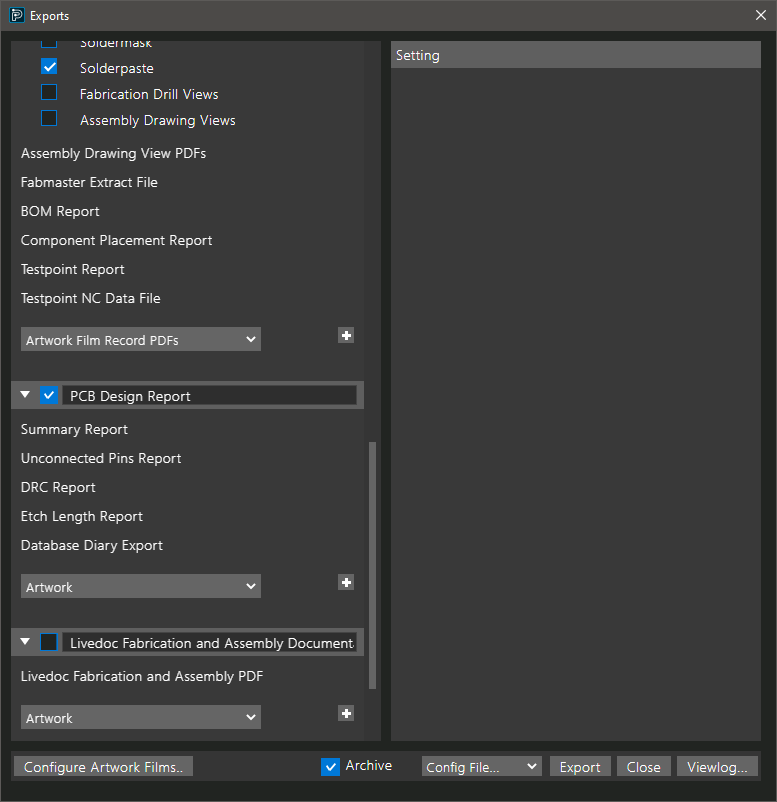
5. Left-click>Export. Yes to the message about the existing Films being replaced.
The “Archive” is checked by default so, with the settings above, two zip files will be created in the folder that holds the headphone.brd file. One for Fabrication_Gerber and another for Reports.
Viewing the completed board in 3D
Go to the Visibility panel and the Display section and set the Mode to 3D. If the provided footprint library was used, the footprints within that will have 3D models mapped and the board will be seen with the assigned 3D models.
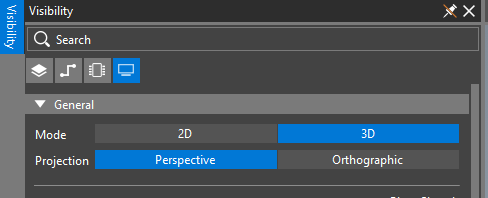
Roll the mouse wheel to Zoom., control+middle mouse click to Pan and shift+middle mouse click to Rotate.
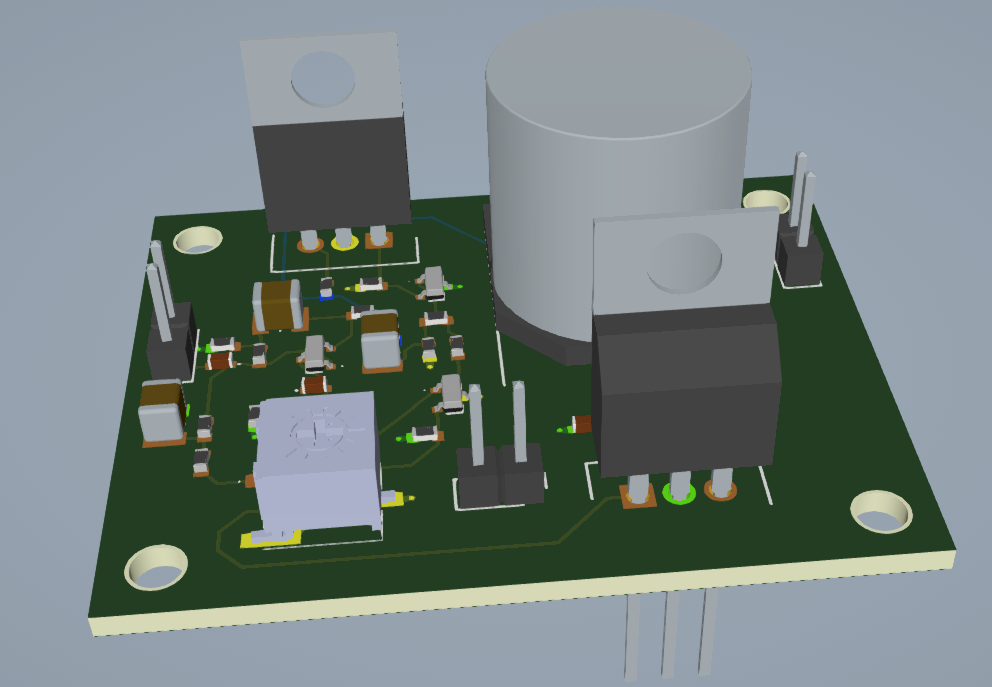
The generic libraries don't have any 3D models provided but the 3D models from the "stepGeneric" folder of the downloaded data could be mapped. The footprints from the online sources may have 3D models as part of the download for the selected parts but, typically, they won't be mapped.
The image below is from an example placement of the components using the generic libraries. This is only using the Place Boundaries and assigned heights so the display has no model details.
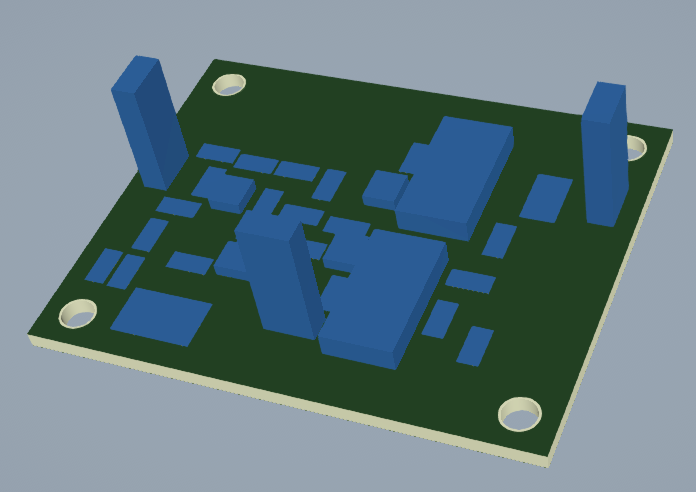
To illustrate the 3D model assignment, the parts from the board using the generic libraries will be mapped to a 3D model from the downloaded data
In the 3D view, use View>Panels>3D Model Mapper to get the 3D Model Mapper active, if it isn't already
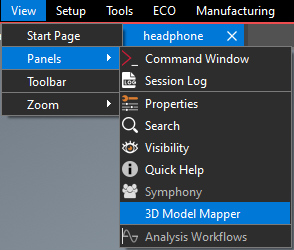
At the right, the Models and mapping for the footprints in the design will be shown
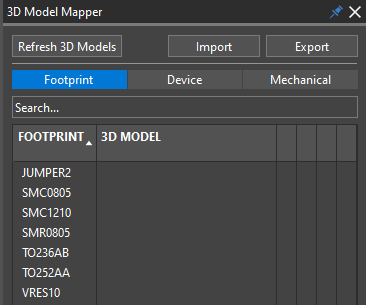
Hover the mouse over one of the footprint entries to see the additional buttons. The "..." button will allow browsing for the 3D Model to assign.
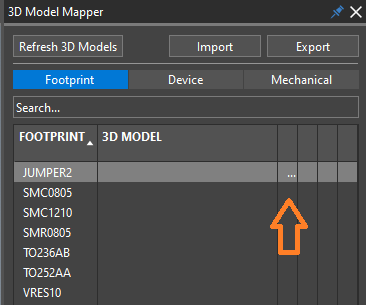
In this first case, the Jumper2 STEP Model is assigned and mapped correctly, that isn't always the case as following examples will show. Once mapped the Model file name and the other buttons will be active.
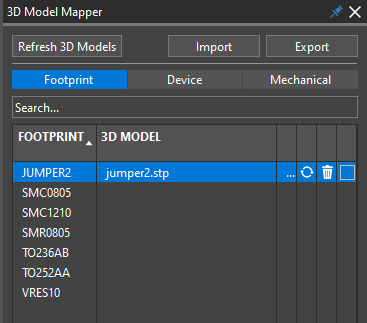
Next the 3D Model for the VRES10 will be mapped. Follow the previous steps to get the VRES10 STEP Model assigned. It's clear from the 3D view that the mapping is incorrect.

Change the mapping option from Full Board to Device Only. This will display just the specific model to be mapped and make mapping much easier
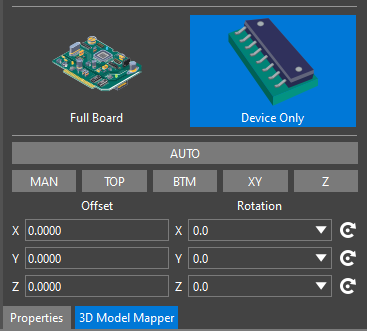
Left-click the Auto button in the mapping options to see if the mapper can work out the mapping from the component and 3D Model. That doesn't work well in this case so some more mapping will be required. Manipulate the 3D view using the middle mouse controls above so that the bottom face of the 3D model is in view. Left-click the Top button in the mapping options and hover the mouse over the bottom face of the 3D model.
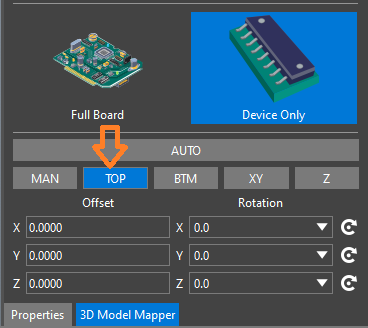
Left-click on the bottom face of the 3D model to set board mounting.
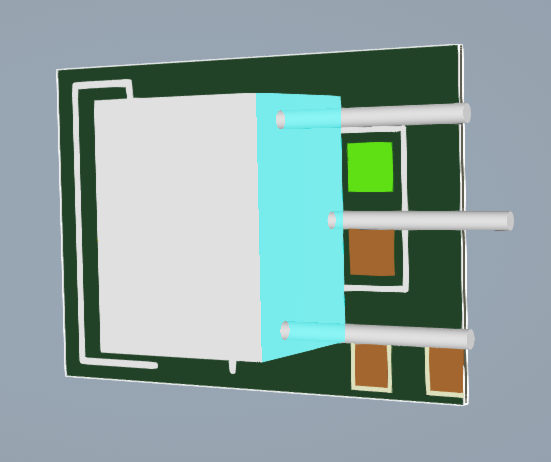
That is looking better but the mapping still isn't ideal.
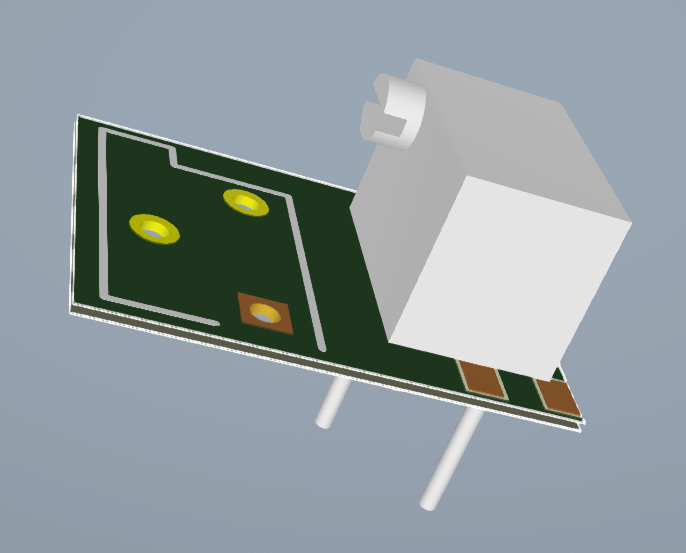
There are a couple of ways to change this. Firstly with XY: left-click the XY button in the 3D Mapper.
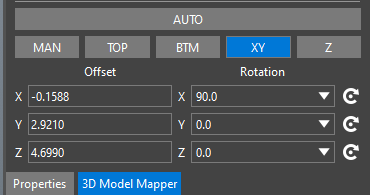
Use the middle mouse controls to get to the bottom view of the Pins and board. Left-click the "head" of a Pin.
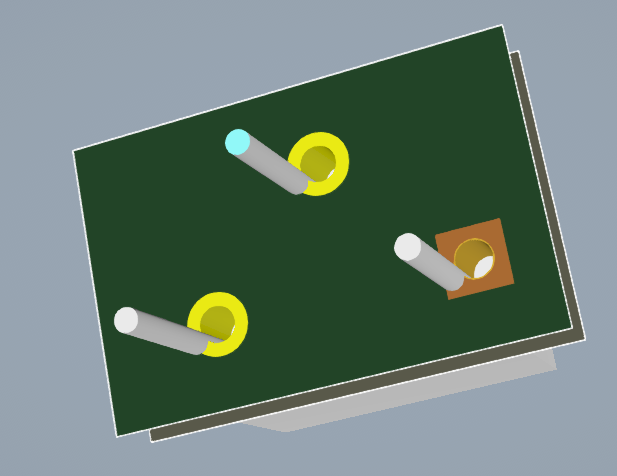
Left-click on the "hole" that the Pin will mount through and right-click>Snap.
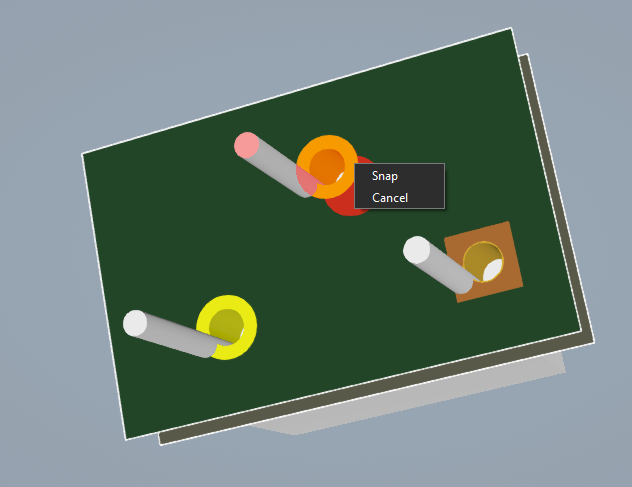
After the "snap" has happened, the Pin and Hole will be aligned. In this case, the rotation worked but, in most cases it would be better practice to select two pins and two holes before snapping to ensure proper alignment.
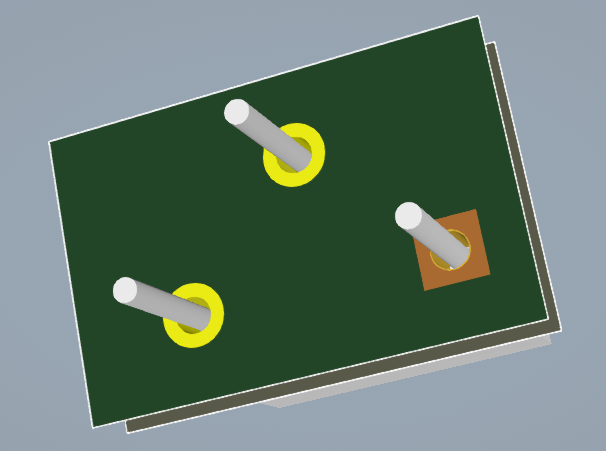
The XY and "snap" works well for through pins since there is a clearly defined location for the Pin. This doesn't usually work as well for surface mount pins as the pads are larger and there isn't such a clearly defined location. The other method is to use manual alignment. Left-click the Man(ual) button in the 3D mapper.
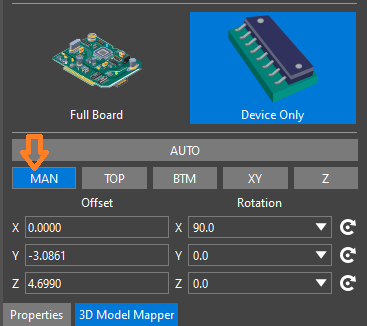
This will activate the 3D axis on the part so that a left-click and drag on an axis will move the 3D model along that axis. The middle mouse controls can be used to maipulate the view of the model to check that the mapping is accurate.
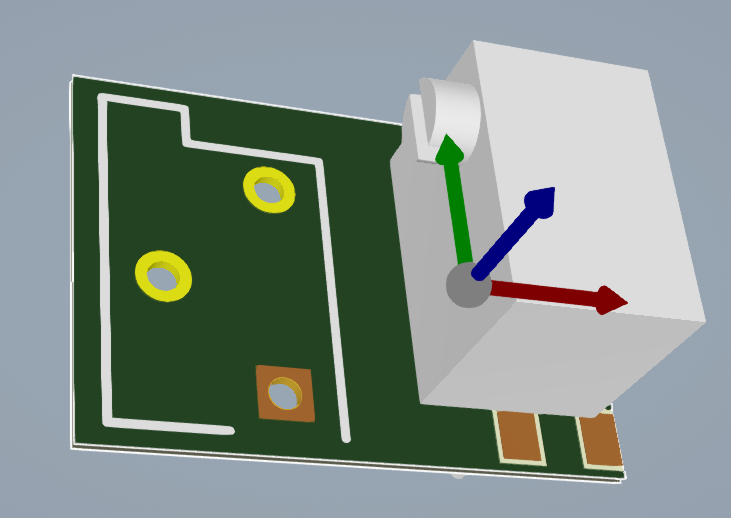
The next image shows the final mapping parameters for the VRES10 footprint.

Here are the mapping parameters for the remaining generic parts
| Footprint: | smc0805 | ||
|---|---|---|---|
| X: | 0.9995 | Rot: | 0.0 |
| Y: | 0.0025 | Rot: | 0.0 |
| Z: | 0.6000 | Rot: | 0.0 |
| Footprint: | smc1210 | ||
| X: | 1.6767 | Rot: | 90.0 |
| Y: | 0.0025 | Rot: | 0.0 |
| Z: | 0.5750 | Rot: | 0.0 |
| Footprint: | smr0805 | ||
| X: | 1.1672 | Rot: | 0.0 |
| Y: | 0.6226 | Rot: | 0.0 |
| Z: | 0.0000 | Rot: | 0.0 |
| Footprint: | to236ab | ||
| X: | -1.0414 | Rot: | 0.0 |
| Y: | 1.0287 | Rot: | 0.0 |
| Z: | 0.0000 | Rot: | 180.0 |
| Footprint: | to252aa5 | ||
| X: | 2.3868 | Rot: | 90.0 |
| Y: | 4.9797 | Rot: | 0.0 |
| Z: | 0.0000 | Rot: | 0.0 |
The next image shows the 3D view after all the 3D models have been assigned and mapped.
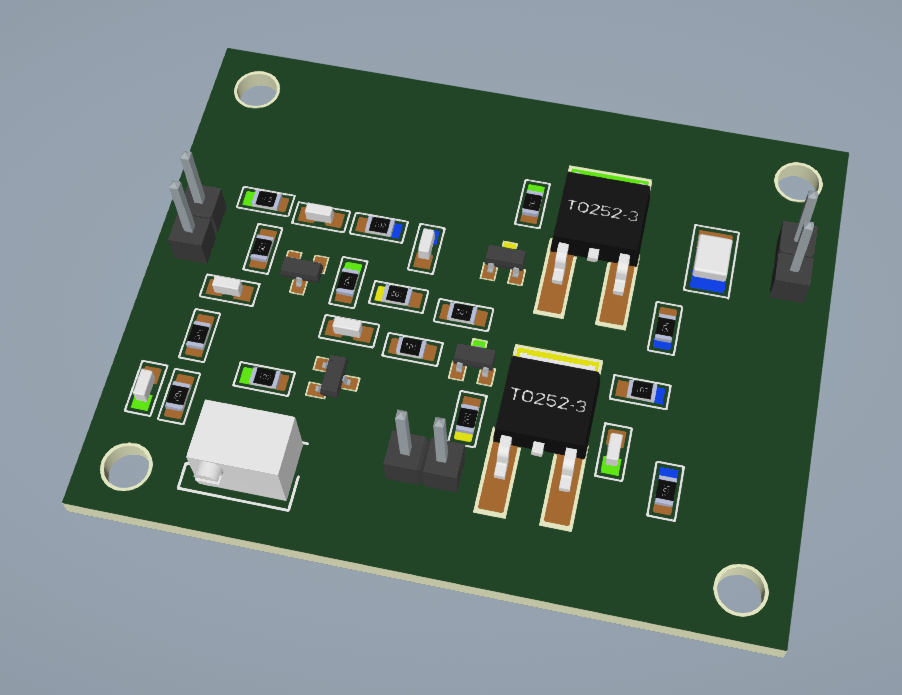
Copyright © 2025, Parallel Systems Ltd.
All rights reserved.
